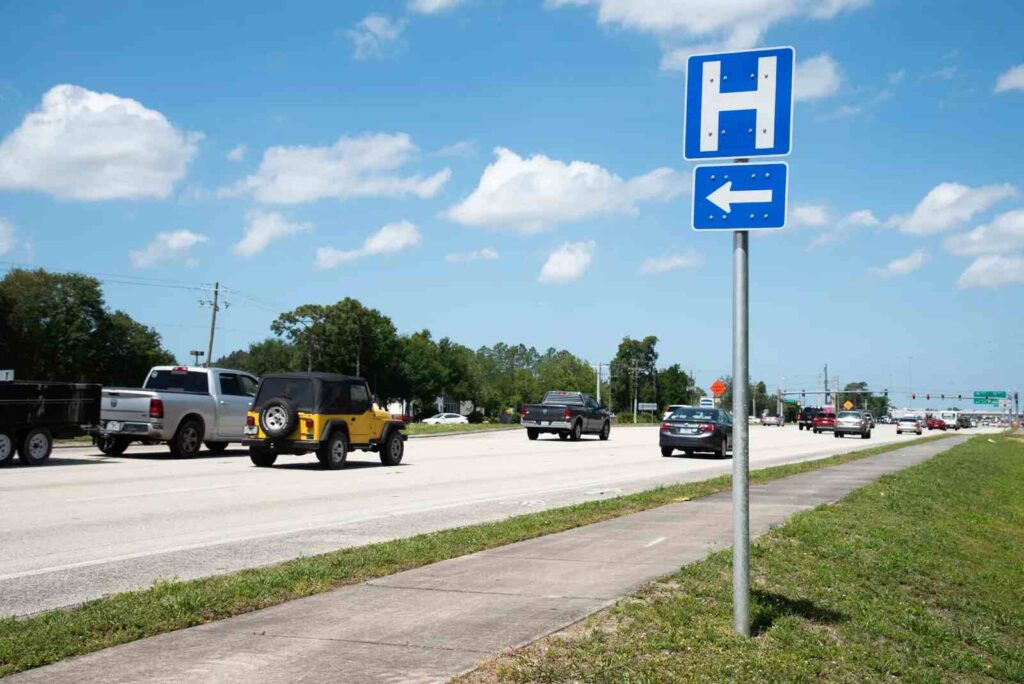Hospital signs play a key role in healthcare settings. They guide patients, visitors, and staff through complex buildings. A clear hospital sign can reduce confusion and improve safety. In this post, we cover the basics, types, design tips, and more. We aim to give you full details on why these signs matter and how to use them well.
Hospitals are busy places. People often feel stressed when they visit. A good hospital sign helps them find their way fast. It can point to emergency rooms, patient areas, or exits. Without proper signs, people may get lost. This can lead to delays in care. Studies show that clear signage cuts down on time wasted asking for directions. That’s why hospital signs are vital for smooth operations.
This guide goes beyond simple overviews. We look at history, rules, materials, and trends. If you run a hospital or design signs, this will help you make better choices. Let’s start with the past.
The History of Hospital Signs
Hospital signs have changed over time. In early days, hospitals used basic markers. These were often hand-painted boards or stone carvings. They showed simple info like “Infirmary” or “Ward.”
The red cross symbol came into use in the 1800s. It started as a mark for medical aid in wars. The Geneva Convention in 1864 made it official for protection. Over time, it became a common hospital sign worldwide. In the U.S., the blue “H” symbol appeared in the mid-1900s. It helps drivers spot hospitals from roads.
In the 20th century, signs got more standard. After World War II, hospitals grew bigger. This led to a need for better wayfinding. Symbols like the Rod of Asclepius – a staff with a snake – became linked to medicine. It’s an old Greek symbol for healing.
By the 1970s, accessibility became a focus. Laws pushed for signs that all could use. Digital tech in the 1990s added new options. Today, hospital signs mix old symbols with modern tools. They keep evolving to meet needs.
Understanding this history shows how signs went from basic to essential. They now support patient care in ways early designers never thought.
Types of Hospital Signs
Hospital signs come in many forms. Each type serves a specific purpose. Here are the main ones.
First, directional signs. These point the way to areas like the ER or labs. They use arrows and simple text. For example, a sign might say “Emergency Room →” with a blue background.
Next, identification signs. These label rooms or departments. Think “Radiology” or “Patient Room 101.” They help staff and visitors know where they are.
Informational signs share key details. They might list visiting hours or safety rules. A common one is “Wash Your Hands” near sinks.
Regulatory signs cover rules and warnings. These include “No Smoking” or “Biohazard.” They often use red for danger.
Wayfinding signs are a big group. They include maps and directories. In large hospitals, these guide people from parking to their goal.
Safety signs focus on risks. Examples are “Slippery Floor” or “Radiation Area.” They prevent accidents.
Digital signs are growing fast. These screens show changing info like wait times or news.
ADA-compliant signs add tactile elements. They have raised letters and Braille for those with vision issues.
Parking signs help outside. They mark spots for staff, visitors, or ambulances.
Each type works together. A hospital might use 10 or more kinds in one building. Choosing the right mix ensures everyone moves safely.
| Type of Hospital Sign | Purpose | Example |
|---|---|---|
| Directional | Guide movement | Arrow to ER |
| Identification | Label locations | Room number |
| Informational | Share details | Visiting hours |
| Regulatory | Enforce rules | No smoking |
| Wayfinding | Provide navigation | Floor map |
| Safety | Warn of hazards | Biohazard |
| Digital | Display updates | Wait time screen |
| ADA-Compliant | Ensure access | Braille sign |
| Parking | Manage vehicles | Visitor lot |
This table sums up the types. It shows how varied hospital signs can be.
Design Principles for Hospital Signs
Good design makes hospital signs work well. Start with clarity. Use big, simple fonts. Sans-serif types like Arial are best. They read easy from far away.
Color matters too. Blue often means info. Red signals warning. Green can show exits. Stick to a few colors for consistency.
Add symbols. A heart icon for cardiology helps non-readers. Universal symbols cut language barriers.
Size is key. Signs should be visible. For hallways, make text at least 2 inches tall.
Placement counts. Put signs at eye level. Avoid clutter. Space them so people see the next one before passing.
Test for usability. Walk the paths. See if signs guide well. Get feedback from users.
Incorporate branding. Use hospital colors or logos. This builds trust.
For digital signs, keep content short. Update often. Use animations sparingly to avoid distraction.
Follow these tips for effective hospital signs. They make spaces user-friendly.
Materials Used in Hospital Signs
Materials affect how long hospital signs last. Aluminum is common. It’s strong and rust-proof. Good for outdoor use.
Plastic works indoors. It’s light and cheap. Acrylic adds a clear look.
Vinyl is flexible. Use it for decals or wraps.
For digital, LED screens are tough. They handle bright lights.
Reflective materials help at night. They shine with car lights.
Choose based on location. Wet areas need waterproof options. High-traffic spots want durable ones.
Costs vary. Metal lasts longer but costs more. Balance budget with needs.
Eco-friendly materials are rising. Recycled plastics cut waste.
Proper materials keep signs looking good for years.
ADA Requirements for Hospital Signs
ADA rules ensure hospital signs help everyone. Key signs need Braille and raised letters.
Height is set. Install between 48 and 60 inches from the floor.
Contrast helps low-vision users. Dark text on light background works.
Fonts must be simple. No italics or scripts.
Not all signs need ADA features. Only permanent room labels do.
Hospitals must follow these. It avoids fines and aids access.
Check local codes too. Some states add rules.
ADA compliance makes signs inclusive.
Wayfinding in Hospitals
Wayfinding means getting from A to B. In hospitals, it’s crucial. Buildings are big and maze-like.
Signs are the main tool. Use consistent arrows and colors.
Maps at entrances help. Show “You Are Here.”
Number floors and zones. Like “Wing A, Level 3.”
Tech adds value. Apps guide via phone.
Staff can assist, but signs reduce their load.
Poor wayfinding causes stress. Good ones calm people.
Plan wayfinding early. Involve architects and sign makers.
Digital Signage in Hospitals
Digital signs are screens that change. They show real-time info.
In waiting rooms, they list wait times. This cuts frustration.
For wayfinding, interactive kiosks let users search paths.
Staff use them for alerts. Like “Code Blue in ER.”
Benefits include easy updates. No printing new signs.
Costs have dropped. Many hospitals add them now.
Content must be fresh. Old info hurts trust.
Digital boosts modern feel. Patients like it.
Benefits of Good Hospital Signage
Clear signs offer many gains. They cut stress for patients. Easy navigation means less worry.
Staff save time. Fewer direction questions let them focus on care.
Safety improves. Warning signs prevent slips or errors.
Patient flow speeds up. This reduces wait times.
Satisfaction rises. Happy visitors give better reviews.
Costs drop long-term. Good signs mean less rework.
In emergencies, signs guide fast response.
Overall, they make hospitals run better.
Case Studies on Hospital Signage
Real examples show impact. At Piedmont Healthcare, new signs cut violence. They set clear rules at entrances.
Frankfurt University Hospital used software to manage signs. It saved time and money on updates.
A study in India found better signs raised satisfaction. Literate and young users liked them most.
OSF HealthCare added donor walls and signs. It improved branding and navigation.
These cases prove signs work. They solve real problems.
Future Trends in Hospital Signage
Trends point to tech. Mobile apps link with signs for personal guides.
AR overlays directions on phone cameras.
AI chats answer location questions.
Eco materials grow. Solar-powered signs save energy.
Personalization rises. Signs greet by name via scans.
Integration with health records. Signs show your appointment spot.
These changes make signs smarter.
How to Choose or Design Hospital Signs
Assess needs first. Map the building. Spot weak areas.
Pick a vendor with healthcare experience.
Budget for install and upkeep.
Test prototypes. Get user input.
Update as hospital changes.
Follow these steps for success.
For more information visit Traffic signs test.
Conclusion
Hospital signs are more than markers. They support care, safety, and ease. From history to trends, we’ve covered it all. Use this info to improve your setup. Good signs lead to better outcomes for all.


